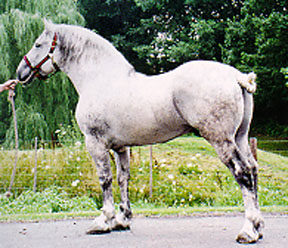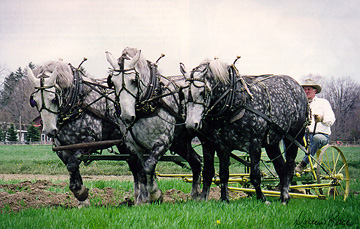

Percheron


Introduction: In the great days of the drafters, this breed was considered the aristocrat of them all. A farmer putting his Percherons to the plow might reflect that this same breed once pulled the carriages of the Bourbon kings of France. If you have any comments or suggestions, please click here. (Most of the work on this page was done before I began citing the dates of my sources; therefore, I do not know when things were written that say "today." Most of my sources so far have been from the 1970's and 80's.)
Names: Percheron. Named for the region in France where it originated.
Origin: Originated in
the northwestern region of France called La Perche. A descendant of the
Flemish horse, it received in medieval times an infusion of desert blood from
horses captured during the Moorish invasion of Europe.
Arrived in England in 1916, as farm and draft
horses. They rapidly became popular there and in the United States and
Canada, but mechanization has inevitably reduced their numbers. At one
time there were more registered in the U.S. than any other breed; total
registration is (1974) about 250,000.
France: La Perche region; Stud: Le Pin in the Orne
Département. (British Percheron Horse Society.)
Breeding: Originally
a cross of Norman with Oriental horses, many
Percherons owe their brilliant eyes and delicately cut ears to Napoleon's gray Arab
chargers, the stallions Gallipoli and Godolphin.
Originating from the heavy local breed. Crossed with
Oriental blood over a long period, first under Charles Martel, later at the time
of the Crusaders, and later still, at the beginning of the nineteenth century.
Description: Arabian influences show in the Percheron's smooth conformation and in its hardy nature. A more recent heavy cross gave added weight, although there is a lighter French type. (I don't know whether this last sentence indicates what was stated in another source or not; namely, that there are both small and large strains of the Percheron breed.)
Action: Energetic, light and free movements in walk and trot.
Body: Neck, short and broad, withers not very high. Shoulders often somewhat short and steep. Back and loins, powerful and well-muscled. Broad, well-muscled quarters.
Color: Nine out of ten Percherons are gray or black (the lighter color was preferred for coach horses as being more visible at night). Usually iron-grey or black.
Hair: Silky coat.
Head: More refined than is usual with other draft breeds. Brilliant eyes and delicately cut ears. Refined, elongated head; broad forehead; large, expressive eyes and low set ears.
Hooves: Relatively small, healthy hooves.
Legs: Clean-legged with excellent feet. Practically devoid of "feathers."
Size: 15.2-17 hands. At 1,900 to 2,200 pounds, the Percheron outweighs the Clydesdale and Suffolk, but it is shorter than the Belgian or Shire, at 16 to 16.3 hands. 16 to 17 hands.
Temperament: Quiet and easy to handle. Good-natured character and energetic temperament.
Features: Very
strong. Often weighs over a ton, but needs little food. Amenable,
active and economical. Both versions are noted for their vigorous trot and
ability to pull extremely heavy loads. (Ideal Percheron combines strength
and refinement.) They were durable, docile, prompt, and they were good
sires. The get of a Percheron stallion was likely to be of good quality,
even out of a mare that was only average.
Heavy, energetic horse. Strong and enduring.
Uses: Popular working horse. The Queen has a fine pair of dappled gray, half-bred Percherons in the Royal Stalls, but the breed is not common in England today. In breeding horses for hunting, it is common for a Percheron to be crossed with a Thoroughbred to get an animal of stamina and substance.
Accomplishments:
Curiosities: Not long ago, most nurseries contained dappled gray rocking horses, first modeled on the handsome French Percheron. Percherons were so much in demand that businessmen bought them as investments.
Profiles: Laet - Finest of all Percheron sires in the U.S., foaled in 1915. His many Grand Champion sons and daughters dominated the major shows of the Twenties and early Thirties. Such a sire is called a "breed builder."
Conclusion: